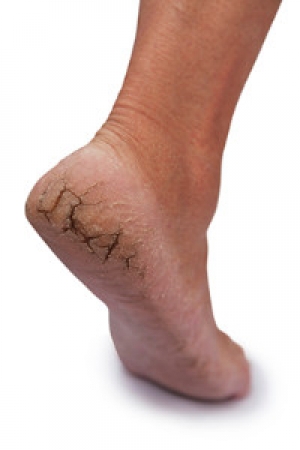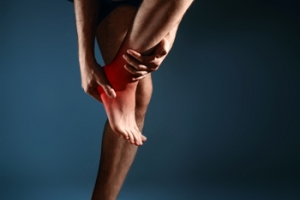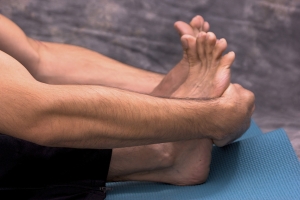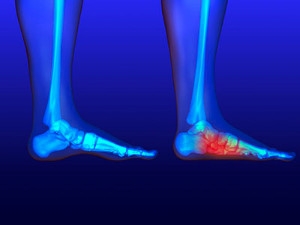Super User
Why Does Athlete’s Foot Occur?
 The condition that is referred to as athlete’s foot is known to be a contagious fungal infection. It may typically occur as a result of fungus entering the feet through tiny cracks in the skin. A perfect environment for this type of fungus to thrive in are warm and moist areas, which may include the inside of shoes and socks. It most commonly affects the space between the toes, and noticeable symptoms may include severe itching and redness, in addition to the skin becoming cracked, which may be painful. It is typically spread by walking barefoot in public pools and surrounding areas, including locker rooms and shower stalls. There may be some patients who have specific medical conditions that may encourage athlete’s foot to develop easier. These may include poor blood circulation, dermatitis, or a genetic trait. If you have any of the symptoms that are associated with athlete’s foot, it is advised to speak to a podiatrist who can properly assist you in choosing the correct treatment.
The condition that is referred to as athlete’s foot is known to be a contagious fungal infection. It may typically occur as a result of fungus entering the feet through tiny cracks in the skin. A perfect environment for this type of fungus to thrive in are warm and moist areas, which may include the inside of shoes and socks. It most commonly affects the space between the toes, and noticeable symptoms may include severe itching and redness, in addition to the skin becoming cracked, which may be painful. It is typically spread by walking barefoot in public pools and surrounding areas, including locker rooms and shower stalls. There may be some patients who have specific medical conditions that may encourage athlete’s foot to develop easier. These may include poor blood circulation, dermatitis, or a genetic trait. If you have any of the symptoms that are associated with athlete’s foot, it is advised to speak to a podiatrist who can properly assist you in choosing the correct treatment.
Athlete’s Foot
Athlete’s foot is often an uncomfortable condition to experience. Thankfully, podiatrists specialize in treating athlete’s foot and offer the best treatment options. If you have any questions about athlete’s foot, consult with Dr. Anna Petrov from Family Foot & Ankle Care. Our doctor will assess your condition and provide you with quality treatment.
What Is Athlete’s Foot?
Tinea pedis, more commonly known as athlete’s foot, is a non-serious and common fungal infection of the foot. Athlete’s foot is contagious and can be contracted by touching someone who has it or infected surfaces. The most common places contaminated by it are public showers, locker rooms, and swimming pools. Once contracted, it grows on feet that are left inside moist, dark, and warm shoes and socks.
Prevention
The most effective ways to prevent athlete’s foot include:
- Thoroughly washing and drying feet
- Avoid going barefoot in locker rooms and public showers
- Using shower shoes in public showers
- Wearing socks that allow the feet to breathe
- Changing socks and shoes frequently if you sweat a lot
Symptoms
Athlete’s foot initially occurs as a rash between the toes. However, if left undiagnosed, it can spread to the sides and bottom of the feet, toenails, and if touched by hand, the hands themselves. Symptoms include:
- Redness
- Burning
- Itching
- Scaly and peeling skin
Diagnosis and Treatment
Diagnosis is quick and easy. Skin samples will be taken and either viewed under a microscope or sent to a lab for testing. Sometimes, a podiatrist can diagnose it based on simply looking at it. Once confirmed, treatment options include oral and topical antifungal medications.
If you have any questions, please feel free to contact one of our offices located in Wheeling and Chicago, IL . We offer the newest diagnostic and treatment technologies for all your foot care needs.
What Is The Most Common Cause Of Cracked Heels?
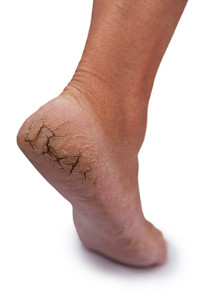 Some authorities have determined that cracked heels may develop as a result of the lack of attention the skin on the heels generally gets. There are many causes why this condition may occur, and having dry skin is generally the most common reason why this ailment may develop. Additionally, if the heels should endure excess pressure from being overweight, the chances of developing cracked heels may increase. There may also be a vitamin deficiency in the body, which may lead to the formation of heel fissures. If you stand for the majority of the day or frequently wear open-back sandals, the skin on the heels may gradually become dry and may lead to this uncomfortable condition. Partial relief may be obtained in washing and drying the feet thoroughly, followed by utilizing a good moisturizer. If you have this condition, please counsel with a podiatrist to learn about preventive measures and additional treatment options for cracked heels.
Some authorities have determined that cracked heels may develop as a result of the lack of attention the skin on the heels generally gets. There are many causes why this condition may occur, and having dry skin is generally the most common reason why this ailment may develop. Additionally, if the heels should endure excess pressure from being overweight, the chances of developing cracked heels may increase. There may also be a vitamin deficiency in the body, which may lead to the formation of heel fissures. If you stand for the majority of the day or frequently wear open-back sandals, the skin on the heels may gradually become dry and may lead to this uncomfortable condition. Partial relief may be obtained in washing and drying the feet thoroughly, followed by utilizing a good moisturizer. If you have this condition, please counsel with a podiatrist to learn about preventive measures and additional treatment options for cracked heels.
Cracked heels are unsightly and can cause further damage to your shoes and feet. If you have any concerns, contact Dr. Anna Petrov from Family Foot & Ankle Care. Our doctor can provide the care you need to keep you pain-free and on your feet.
Cracked Heels
Cracked heels appear unappealing and can make it harder for you walk around in sandals. Aside from looking unpleasant, cracked heels can also tear stockings, socks, and wear out your shoes. There are several methods to help restore a cracked heel and prevent further damage.
How Do You Get Them?
Dry skin is the number one culprit in creating cracked heels. Many athletes, walkers, joggers, and even swimmers suffer from cracked heels. Age and skin oil production play a role to getting cracked heels as well.
Promote Healing
Over the counter medicines can help, especially for those that need instant relief or who suffer from chronic dry feet.
Wear Socks – Wearing socks with medicated creams helps lock in moisture.
Moisturizers – Applying both day and night will help alleviate dryness which causes cracking.
Pumice Stones – These exfoliate and remove dead skin, which allows for smoother moisturizer application and better absorption into the skin.
Change in Diet
Eating healthy with a well-balanced diet will give the skin a fresh and radiant look. Your body responds to the kinds of food you ingest. Omega-3 fatty acids and zinc supplements can also revitalize skin tissue.
Most importantly, seek professional help if unsure how to proceed in treating cracked heels. A podiatrist will help you with any questions or information needed.
If you have any questions, please feel free to contact one of our offices located in Wheeling and Chicago, IL . We offer the newest diagnostic and treatment technologies for all your foot care needs.
Symptoms of Morton’s Neuroma
 If you experience pain and discomfort between the third and fourth toes, you may have a condition that is referred to as Morton’s neuroma. The pain originates from tissue that has been affected as a result of a swollen nerve on the bottom of the foot. Research has shown that being involved in specific sports or wearing high heels may play a significant role in the development of this uncomfortable condition. Patients often notice a burning sensation in the ball of the foot. This may intensify as weight is put on the foot, in addition to a numbness or tingling feeling. Relief may be obtained by wearing correct footwear or gently massaging the affected area. If you feel you may have Morton’s neuroma, it’s advised to seek the counsel of a podiatrist who can properly inform you of correct treatment techniques.
If you experience pain and discomfort between the third and fourth toes, you may have a condition that is referred to as Morton’s neuroma. The pain originates from tissue that has been affected as a result of a swollen nerve on the bottom of the foot. Research has shown that being involved in specific sports or wearing high heels may play a significant role in the development of this uncomfortable condition. Patients often notice a burning sensation in the ball of the foot. This may intensify as weight is put on the foot, in addition to a numbness or tingling feeling. Relief may be obtained by wearing correct footwear or gently massaging the affected area. If you feel you may have Morton’s neuroma, it’s advised to seek the counsel of a podiatrist who can properly inform you of correct treatment techniques.
Morton’s neuroma is a very uncomfortable condition to live with. If you think you have Morton’s neuroma, contact Dr. Anna Petrov of Family Foot & Ankle Care. Our doctor will attend to all of your foot care needs and answer any of your related questions.
Morton’s Neuroma
Morton's neuroma is a painful foot condition that commonly affects the areas between the second and third or third and fourth toe, although other areas of the foot are also susceptible. Morton’s neuroma is caused by an inflamed nerve in the foot that is being squeezed and aggravated by surrounding bones.
What Increases the Chances of Having Morton’s Neuroma?
- Ill-fitting high heels or shoes that add pressure to the toe or foot
- Jogging, running or any sport that involves constant impact to the foot
- Flat feet, bunions, and any other foot deformities
Morton’s neuroma is a very treatable condition. Orthotics and shoe inserts can often be used to alleviate the pain on the forefront of the feet. In more severe cases, corticosteroids can also be prescribed. In order to figure out the best treatment for your neuroma, it’s recommended to seek the care of a podiatrist who can diagnose your condition and provide different treatment options.
If you have any questions, please feel free to contact one of our offices located in Wheeling and Chicago, IL . We offer the newest diagnostic and treatment technologies for all your foot care needs.
Read more about Morton's NeuromaWhy do Stress Fractures Develop?
 If you enjoy the sport of running or jogging, you may develop a stress fracture. This may gradually occur from the frequent repetitive motion that accompanies this type of activity. Despite the fact that many people who engage in sports may endure the discomfort of a stress fracture, certain individuals may be prone to developing this ailment. This may include having a medical condition that may weaken the bones, or experiencing a disorder that may affect the nerves. This may result in a loss of feeling. The pain that is associated with this condition may not be felt. The noticeable symptoms may include pain and discomfort and may be more intense in one foot. After an MRI or bone scan is performed, the proper treatment options can be discussed, such as possibly wearing a cast or boot or taking certain medications. Please consult with a podiatrist if you have endured a stress fracture and would like information about correct treatment techniques that are right for you.
If you enjoy the sport of running or jogging, you may develop a stress fracture. This may gradually occur from the frequent repetitive motion that accompanies this type of activity. Despite the fact that many people who engage in sports may endure the discomfort of a stress fracture, certain individuals may be prone to developing this ailment. This may include having a medical condition that may weaken the bones, or experiencing a disorder that may affect the nerves. This may result in a loss of feeling. The pain that is associated with this condition may not be felt. The noticeable symptoms may include pain and discomfort and may be more intense in one foot. After an MRI or bone scan is performed, the proper treatment options can be discussed, such as possibly wearing a cast or boot or taking certain medications. Please consult with a podiatrist if you have endured a stress fracture and would like information about correct treatment techniques that are right for you.
Activities where too much pressure is put on the feet can cause stress fractures. To learn more, contact Dr. Anna Petrov from Family Foot & Ankle Care. Our doctor can provide the care you need to keep your pain free and on your feet.
Dealing with Stress Fractures of the Foot and Ankle
Stress fractures occur in the foot and ankle when muscles in these areas weaken from too much or too little use. The feet and ankles then lose support when walking or running from the impact of the ground. Since there is no protection, the bones receive the full impact of each step. Stress on the feet can cause cracks to form in the bones, thus creating stress fractures.
What Are Stress Fractures?
Stress fractures occur frequently in individuals whose daily activities cause great impact on the feet and ankles. Stress factors are most common among:
- Runners
- People affected with Osteoporosis
- Tennis or basketball players
- Gymnasts
- High impact workouts
Symptoms
Pain from the fractures occur in the area of the fractures and can be constant or intermittent. It will often cause sharp or dull pain with swelling and tenderness. Engaging in any kind of activity which involves high impact will aggravate pain.
If you have any questions please feel free to contact one of our offices located in Wheeling and Chicago, IL . We offer the newest diagnostic and treatment technologies for all your foot and ankle needs.
How to Properly Stretch the Feet
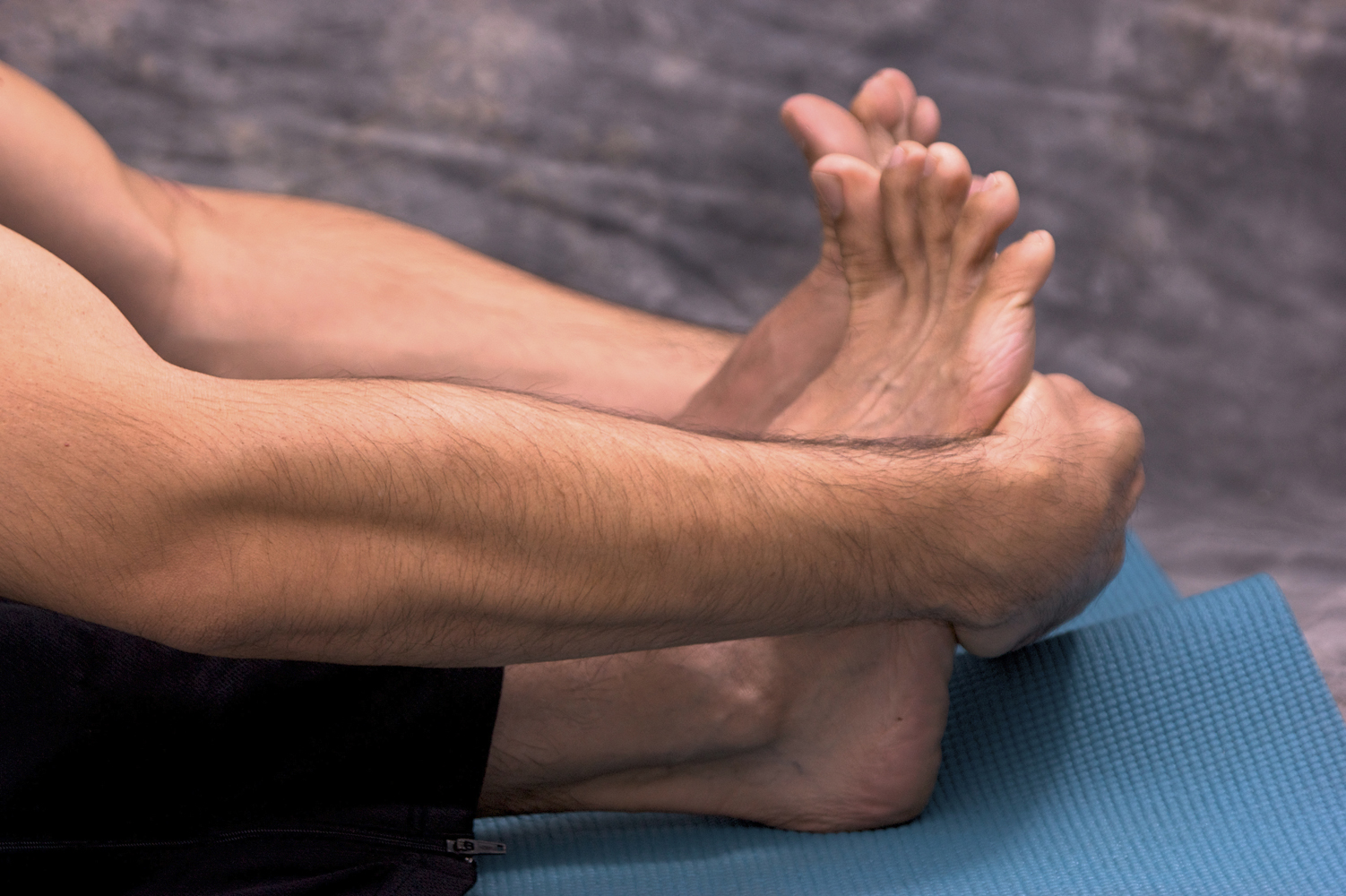 The benefits of performing stretching techniques for your feet may positively affect the general well-being of the body. Research has shown that walking may be one of the best forms of exercising the feet, in addition to flexing and pointing toes frequently throughout the day. The feet will become stronger when resistance exercises are performed, and this is typically accomplished by utilizing exercise bands or weights. Flexibility may be attained by sitting in a chair, and rotating one ankle at a time in one direction. This ankle rotation should be repeated approximately 15 times, followed by reversing the direction, and repeating on the other foot. Additionally, the feet will feel good when the soles are properly stretched, and this may be accomplished by pressing the toes into the ground while lifting the heel. It’s suggested to speak with a podiatrist if you would like additional information on how to perform foot stretches.
The benefits of performing stretching techniques for your feet may positively affect the general well-being of the body. Research has shown that walking may be one of the best forms of exercising the feet, in addition to flexing and pointing toes frequently throughout the day. The feet will become stronger when resistance exercises are performed, and this is typically accomplished by utilizing exercise bands or weights. Flexibility may be attained by sitting in a chair, and rotating one ankle at a time in one direction. This ankle rotation should be repeated approximately 15 times, followed by reversing the direction, and repeating on the other foot. Additionally, the feet will feel good when the soles are properly stretched, and this may be accomplished by pressing the toes into the ground while lifting the heel. It’s suggested to speak with a podiatrist if you would like additional information on how to perform foot stretches.
Stretching the feet is a great way to prevent injuries. If you have any concerns with your feet consult with Dr. Anna Petrov from Family Foot & Ankle Care. Our doctor will assess your condition and provide you with quality foot and ankle treatment.
Stretching the Feet
Being the backbone of the body, the feet carry your entire weight and can easily become overexerted, causing cramps and pain. As with any body part, stretching your feet can serve many benefits. From increasing flexibility to even providing some pain relief, be sure to give your feet a stretch from time to time. This is especially important for athletes or anyone performing aerobic exercises, but anyone experiencing foot pain or is on their feet constantly should also engage in this practice.
Great ways to stretch your feet:
- Crossing one leg over the others and carefully pull your toes back. Do 10-20 repetitions and repeat the process for each foot
- Face a wall with your arms out and hands flat against the wall. Step back with one foot and keep it flat on the floor while moving the other leg forward. Lean towards the wall until you feel a stretch. Hold for 30 seconds and perform 10 repetitions for each foot
- Be sure not to overextend or push your limbs too hard or you could risk pulling or straining your muscle
Individuals who tend to their feet by regular stretching every day should be able to minimize foot pain and prevent new problems from arising.
If you have any questions, please feel free to contact one of our offices located in Wheeling and Chicago, IL . We offer the newest diagnostic and treatment technologies for all your foot care needs.
Stretching Your Feet
Debilitating foot pain is a problem for many people. But just as stretching the torso can help alleviate back pain, stretching the feet can also help mend existing foot problems and prevent future ones.
The feet, as the body’s foundation, carry the body’s entire weight and can get easily strained from overexertion. Persistent sharp pain and cramping in the feet are often common concerns. Foot pain and foot problems can be due to any number of causes, and in many cases pain may be eased without medication or doctor visits. It is always a good idea, however, to first rule out any serious medical issues with a physician.
Stretching can help relax the feet and alleviate pain, but is especially important before heavy aerobic exercise. Stretching before such activities can help you avoid experiencing painful cramps or strained foot muscles. Stretches should be performed slowly and deliberately without forceful pulling. The stretch should be held for several seconds before relaxing.
A great way to stretch out and loosen up the foot muscles while sitting is to cross one leg over the other and pull the toes carefully back without overextending. Start by resting the left ankle on the right knee. With the left hand, gently flex the left foot by pulling back on the toes. Do not pull too hard; just hard enough to feel the stretch in the arch of the foot. Then point the toes of the left foot as far as you can. Rotate the motion of pointing with pulling back on the toes. This should relax and stretch the muscles on the bottom and the top of the foot. Doing this stretch ten to twenty times should bring relief. Repeat the whole process for the other foot by resting the right ankle on the left knee.
A stretch that focuses on the often injured Achilles tendon involves standing and facing a wall with your arms out and hands flat against the wall. Step back with one foot, keeping it flat against the floor. Move the other leg forward and lean toward the wall. You should feel a stretch through the back of your leg and your Achilles tendon, but do not push yourself too much. Stop when you feel a stretching sensation, and hold for 30 seconds. Ten repetitions may be done for each foot.
Stretching the feet is important for athletes or those performing aerobic exercise, but it can also help anyone with foot pain caused by poor footwear, plantar fasciitis, or long hours standing and walking. Individuals who tend to their feet by regularly stretching every day should be able to minimize foot pain and prevent new problems from arising.
Common Running Injuries
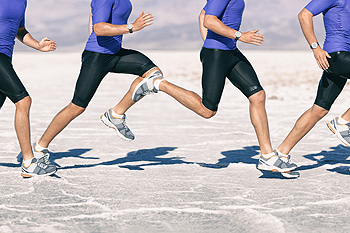 Research has shown the majority of people who enjoy running and jogging will experience a minimum of one injury per year. This is due to improper training techniques or failing to warm the muscles up adequately before running. The thought of injuries incurred while running, will typically affect most joggers negatively, depending on the severity of the injury. Serious mishaps may represent mandatory time off from this sport, so proper healing can commence. Some of the injuries that are feared is Achilles tendinitis, which generally affects the back of the heel and calf. This may be able to prevent by stretching the Achilles tendon, and this is often accomplished by standing on a step and raising the heel up, followed by lowering it down. Additionally, shin splints is a common injury that many runners endure, and this may be prevented by wearing the correct shoes while running, in addition to strengthening the calves. Please speak with a podiatrist if you would like additional information about how to prevent running injuries.
Research has shown the majority of people who enjoy running and jogging will experience a minimum of one injury per year. This is due to improper training techniques or failing to warm the muscles up adequately before running. The thought of injuries incurred while running, will typically affect most joggers negatively, depending on the severity of the injury. Serious mishaps may represent mandatory time off from this sport, so proper healing can commence. Some of the injuries that are feared is Achilles tendinitis, which generally affects the back of the heel and calf. This may be able to prevent by stretching the Achilles tendon, and this is often accomplished by standing on a step and raising the heel up, followed by lowering it down. Additionally, shin splints is a common injury that many runners endure, and this may be prevented by wearing the correct shoes while running, in addition to strengthening the calves. Please speak with a podiatrist if you would like additional information about how to prevent running injuries.
Exercising your feet regularly with the proper foot wear is a great way to prevent injuries. If you have any concerns about your feet, contact Dr. Anna Petrov of Family Foot & Ankle Care. Our doctor will treat your foot and ankle needs.
How to Prevent Running Injuries
Many common running injuries are caused by overuse and overtraining. When the back of the kneecap starts wearing out and starts causing pain in your knee, this is commonly referred to as runner’s knee. Runner’s knee is a decrease in strength in your quadriceps and can occur if you’re not wearing properly fitted or supporting shoes. To prevent runner’s knee, focusing on hip strengthening is a good idea, as well as strengthening your quads to keep the kneecaps aligned.
What Are Some Causes of Running Injuries?
- One cause of a common running injury is called iliotibial band syndrome.
- Plantar fasciitis is also another common injury.
- Stress fractures can occur from overtraining, lack of calcium, or even your running style.
Best Ways to Prevent Running Injuries
- Wear footwear that fits properly and suits your running needs.
- Running shoes are the only protective gear that runners have to safeguard them from injury.
- Make a training schedule. Adding strengthening exercises as well as regular stretching can help keep you strong and limber and can lessen the possibility of injuries.
- Stretching keeps muscles limber; this will help you gain better flexibility.
If you have any questions please feel free to contact one of our offices located in Wheeling and Chicago, IL . We offer the newest diagnostic and treatment technologies for all your foot and ankle needs.
Read more about How to Prevent Running InjuriesSymptoms and Causes of Flat Feet
 Many people have a foot condition that is referred to as flat feet. This term is used if the patient has extremely low arches or the arch doesn't exist at all. The purpose of the arch is to aid in balancing the weight of the body as it extends to the feet and legs. The foot will benefit if the arch is flexible and strong, which may help in maintaining balance on different types of surfaces. There are several common symptoms that many patients are aware of including pain that may affect the entire foot and ankle, swelling on the inside of the foot, and a stiff feeling that may be experienced in one or both feet. Possible causes for this condition to develop may originate from an inherited trait, an injury that may have occurred to the foot or ankle, or a medical condition such as arthritis. A podiatrist can perform a correct diagnosis to determine the severity of this ailment in addition to discussing proper treatment techniques.
Many people have a foot condition that is referred to as flat feet. This term is used if the patient has extremely low arches or the arch doesn't exist at all. The purpose of the arch is to aid in balancing the weight of the body as it extends to the feet and legs. The foot will benefit if the arch is flexible and strong, which may help in maintaining balance on different types of surfaces. There are several common symptoms that many patients are aware of including pain that may affect the entire foot and ankle, swelling on the inside of the foot, and a stiff feeling that may be experienced in one or both feet. Possible causes for this condition to develop may originate from an inherited trait, an injury that may have occurred to the foot or ankle, or a medical condition such as arthritis. A podiatrist can perform a correct diagnosis to determine the severity of this ailment in addition to discussing proper treatment techniques.
Flatfoot is a condition many people suffer from. If you have flat feet, contact Dr. Anna Petrov from Family Foot & Ankle Care. Our doctor will treat your foot and ankle needs.
What Are Flat Feet?
Flatfoot is a condition in which the arch of the foot is depressed and the sole of the foot is almost completely in contact with the ground. About 20-30% of the population generally has flat feet because their arches never formed during growth.
Conditions & Problems:
Having flat feet makes it difficult to run or walk because of the stress placed on the ankles.
Alignment – The general alignment of your legs can be disrupted, because the ankles move inward which can cause major discomfort.
Knees – If you have complications with your knees, flat feet can be a contributor to arthritis in that area.
Symptoms
- Pain around the heel or arch area
- Trouble standing on the tip toe
- Swelling around the inside of the ankle
- Flat look to one or both feet
- Having your shoes feel uneven when worn
Treatment
If you are experiencing pain and stress on the foot you may weaken the posterior tibial tendon, which runs around the inside of the ankle.
If you have any questions please feel free to contact one of our offices located in Wheeling and Chicago, IL . We offer the newest diagnostic and treatment technologies for all your foot and ankle needs.
Flat Feet
Flatfoot is a foot condition in which the arch of the foot has either partially or totally dropped or has never developed. While it is common in babies and small children, it can become a problem for them in adulthood if the arch never forms. For adults, the development of flat feet can be brought upon by injury, as a result of pregnancy due to increased elasticity, or obesity. Those who have health concerns such as rheumatoid arthritis or diabetes may also be at greater risk for developing the condition.
If you suspect that you have flat feet, it is best to consult your podiatrist. Your foot doctor will examine the suspected foot and observe how it looks while you sit and stand. He or she may take an X-ray to determine how serious the condition is. Some common signs of flatfoot include toe drift, in which the toes and front part of the foot point outward, a short Achilles tendon, and a heel that tilts outwardly while the ankle tilts inward.
Once flatfoot has been diagnosed, your podiatrist may suggest one of several treatment options. Flat feet can be rigid, in which the feet appear to have no arch even when the person is not standing; or flexible, in which the person appears to have an arch while not standing, but once standing the arch disappears. Those with flexible flatfoot may be told to reduce any activities that cause pain and to avoid extended periods of walking or standing. Another suggestion may be weight loss, as excessive weight may be placing pressure on the arches
In few cases, if the condition is severe and all other methods have been exhausted surgery may be required. This is normally avoided, however, due to a lengthy recovery time and high cost.
Causes of Sesamoiditis
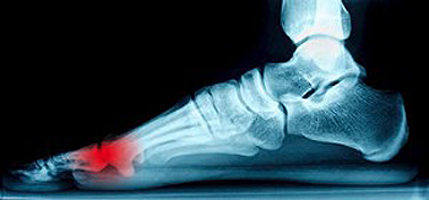 The sesamoid bones are located in the tendon that aids in moving the big toe. One of the several functions of these types of bones is to help support the body’s weight. If the area surrounding these particular bones should become inflamed, a condition that is referred to as sesamoiditis may occur. This may be the result of a sudden injury or gradual loss of strength in the bones. The pain is typically felt in the ball of the foot, and the inflammation may extend to the inside of the arch. It may commonly be observed in young people who are physically active, in addition to runners and ballet dancers which may occur due to the amount of force that the sesamoid bones must endure. Some of the symptoms that may be connected with this condition may include bruising, swelling, or difficulty in straightening the big toe. If you feel you may have sesamoiditis, please schedule a consultation with a podiatrist who can provide a correct diagnosis in addition to discussing correct treatment options.
The sesamoid bones are located in the tendon that aids in moving the big toe. One of the several functions of these types of bones is to help support the body’s weight. If the area surrounding these particular bones should become inflamed, a condition that is referred to as sesamoiditis may occur. This may be the result of a sudden injury or gradual loss of strength in the bones. The pain is typically felt in the ball of the foot, and the inflammation may extend to the inside of the arch. It may commonly be observed in young people who are physically active, in addition to runners and ballet dancers which may occur due to the amount of force that the sesamoid bones must endure. Some of the symptoms that may be connected with this condition may include bruising, swelling, or difficulty in straightening the big toe. If you feel you may have sesamoiditis, please schedule a consultation with a podiatrist who can provide a correct diagnosis in addition to discussing correct treatment options.
Sesamoiditis is an unpleasant foot condition characterized by pain in the balls of the feet. If you think you’re struggling with sesamoiditis, contact Dr. Anna Petrov of Family Foot & Ankle Care. Our doctor will treat your condition thoroughly and effectively.
Sesamoiditis
Sesamoiditis is a condition of the foot that affects the ball of the foot. It is more common in younger people than it is in older people. It can also occur with people who have begun a new exercise program, since their bodies are adjusting to the new physical regimen. Pain may also be caused by the inflammation of tendons surrounding the bones. It is important to seek treatment in its early stages because if you ignore the pain, this condition can lead to more serious problems such as severe irritation and bone fractures.
Causes of Sesamoiditis
- Sudden increase in activity
- Increase in physically strenuous movement without a proper warm up or build up
- Foot structure: those who have smaller, bonier feet or those with a high arch may be more susceptible
Treatment for sesamoiditis is non-invasive and simple. Doctors may recommend a strict rest period where the patient forgoes most physical activity. This will help give the patient time to heal their feet through limited activity. For serious cases, it is best to speak with your doctor to determine a treatment option that will help your specific needs.
If you have any questions please feel free to contact one of our offices located in Wheeling and Chicago, IL . We offer the newest diagnostic and treatment technologies for all your foot and ankle needs.
Read more about Sesamoiditis



